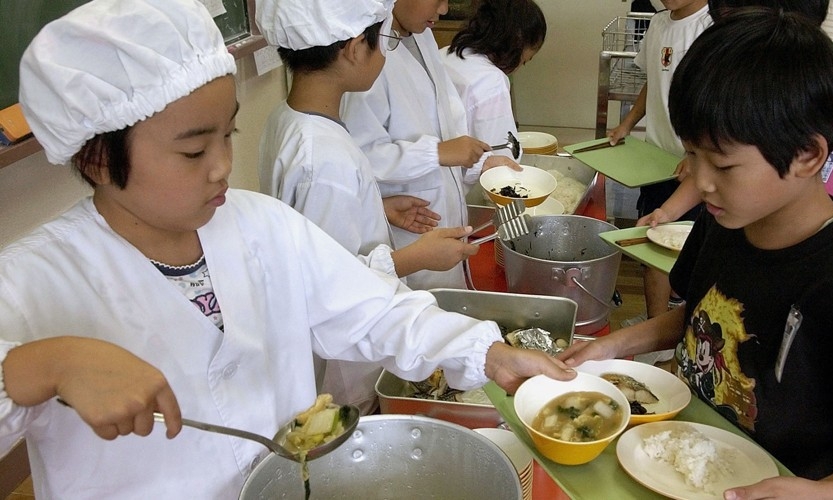 School lunch in Japanese schools is not only about eating, but also it teaches the students to serve each other and the right eating etiquette (Image via CityLab)
School lunch in Japanese schools is not only about eating, but also it teaches the students to serve each other and the right eating etiquette (Image via CityLab)
Monitoring nutrition for children, Japan prioritizes healthy lunch
A report released by the United Nations Children's Fund (UNICEF) on Tuesday showed that Japan reigns the list of children’s health indicators in developed countries around the world. Japan shows low infant mortality and a low rate of underweight children.Also, the Asian nation provides high nutrition food with a low rate of obesity at 14.42%, the lowest among 41 developed countries on the list. The United States has the most obesity rate at 41.86%, not really a satisfactory achievement by the Western country.
How the Japanese do that? Lunch. Japanese nutritional experts stated that various provisions assure children’s health in Japan. However, lunch is one of the most essentials.
Japan’s school lunch program can be traced back as old as 1889 in Yamagata Prefecture. At that time, the only menu for school lunch was rice balls (onigiri) and grilled fish. Nutritional experts said that to cut costs on food, some of the Japanese families tended to give their children more carbs and sugar, less protein; hence, the main cause of obesity.
After WWII, the Japanese then realized that they should have regulated a balanced lunch for the children amid the food shortage and malnutrition among Japanese children. Therefore, the school lunch program was extended from Yamagata to throughout Japan, helping families under the poverty line.
The menus of school lunches for primary and junior high schools throughout Japan have been regulated by nutritionists. The lunch has to be balanced in terms of 600 – 700 calories, consisting of carbohydrates, protein (in the form of meat or fish), and vegetables.
The ingredients for these lunches are mostly homegrown, and the price of the lunch is relatively cheap at around ¥270 (US$2.50).
According to Japan’s Ministry of Education, balanced school lunch is important to provide nutrition which cannot be provided at home.
Granted, it is costly, however, most of these lunches are subsidized. Besides, no packed lunches are allowed. Unlike the Western lunch system where the cafeteria is provided, Japanese students serve lunch in turns according to the schedule.
For the Japanese, lunch is not about eating. It is also a part of education as regulated under the law where the Japanese children learn about culture, education, and unity. Children serve each other, and they learn eating etiquettes and how to clean up after each other.
Besides lunch, mandatory health check also plays a pivotal role in keeping the Japanese children healthy. Not a surprised one, parents are notified by the local government regarding health checks in their children’s schools.
Source: https://bit.ly/2ITMdII
 English
English Japan
Japan

small round blue pill vitamins for libido men grapefruit and vitamin b12 absorption walgreens viagra best supplement for women's libido 10 mg cialis daily dose
how to improve your libido men viagra meaning sildenafil 50mg tablets viagra spray for sale red pill for ed viagra en ligne xtampza er patient assistance program selling gold prices today generic viagra overnight shipping instant natural viagra google sildenafil 20 mg walmart pharmacy prescription history buying viagra lipitor side effects lawsuit 5mg generic cialis best price cheap vigora 100 viagra otc female enhancement pills that work drugs for women's libido prescription insurance plans compra viagra 20mg cialis vs 100mg viagra how to take viagra for maximum effect best libido booster for men over 50 viagra on line gnc male enhancement products results of viagra use viagra cock viagra cost at walgreens
how to get a prescription online pharmaceutical companies pending fda approval gnc products side effects of viagra new ed drugs energy pills gnc
cost of viagra cvs pharmacy all natural herbal male enhancement pain meds without written prescription viagras cialis 30 day sample cvs pharmacy sildenafil
diazepam 10 mg viagra warning label joke best price 100mg generic viagra cost of viagra sildenafil india pharmacy review sildenafil effect time